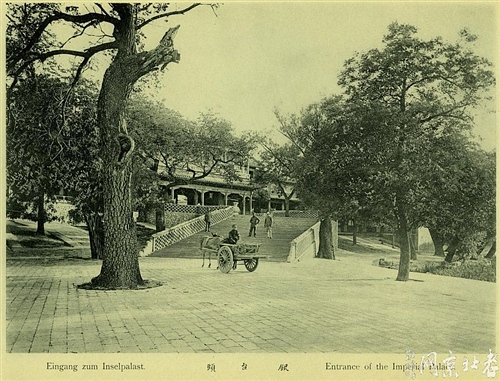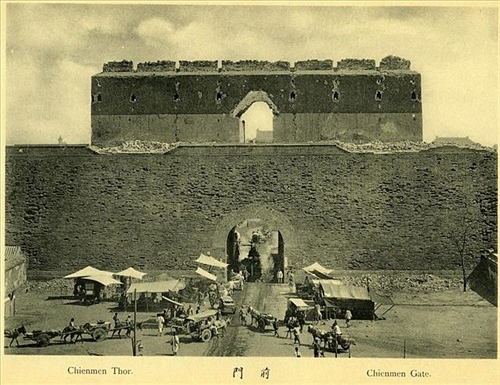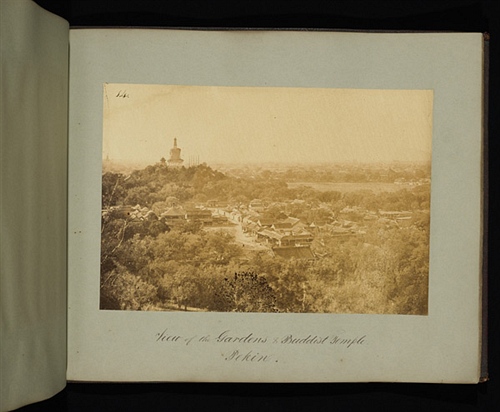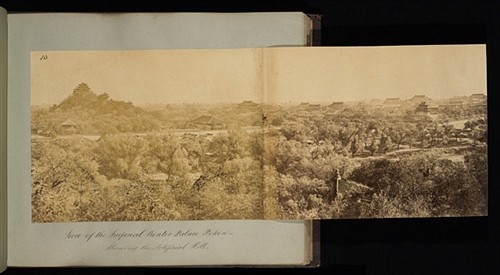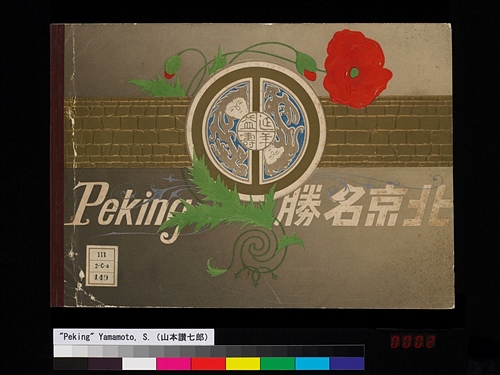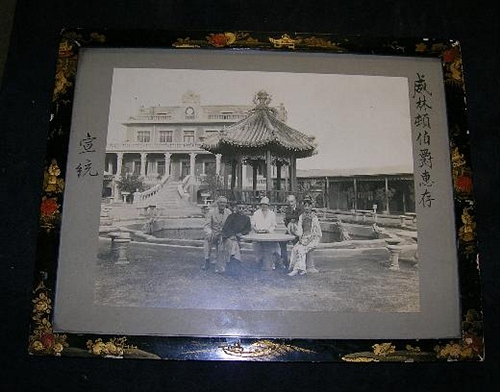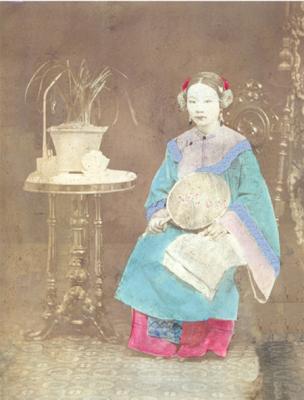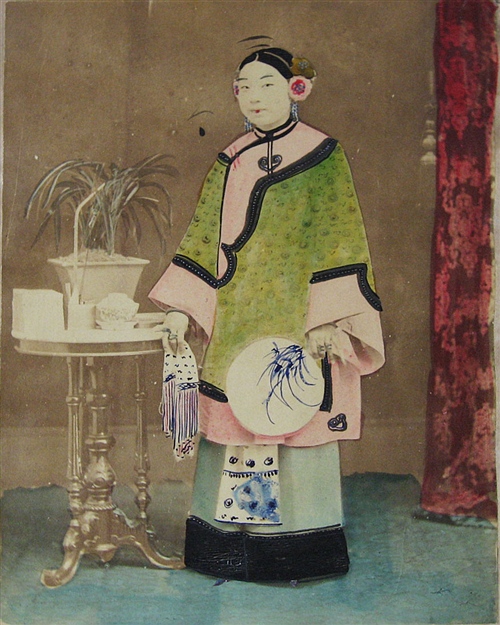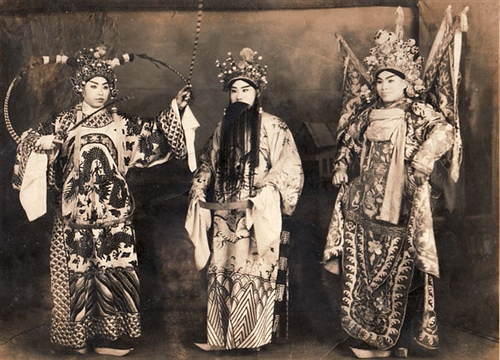上一张和昨天同一系列的片子。虽然照片的标识上写的是“银台头”,而实际上北京并没有这么个地方,实际上应该是发音相近的“瀛台头”。
一张1900年左右前门被烧毁的老照片
好文一篇:Historic Photographic Processes
Historic Photographic Processes
Invented in 1850 by Louis Désiré Blanquart-Evrard, the albumen print became the dominant photographic printing process for nearly fifty years. Most of the albumen prints in the A. D. White Architectural Photographs Collection were produced between 1865 and 1895.
Technical definition:
First, a thin piece of paper is coated with an emulsion containing both egg white (albumen) and salt (usually sodium chloride). A subsequent immersion in a bath of silver nitrate renders the paper light-sensitive. The paper is next dried in the dark, then placed in a frame under a glass negative (most often, it was a glass negative with a collodion emulsion) and exposed in direct sunlight until the image achieves the proper level of darkness (from a few minutes to an hour, depending on light conditions). Albumen prints are thus contact printed, or placed in direct contact with the negative. Since the image emerges as a direct result of exposure to light and without the aid of a developing solution, the albumen print is a Printed-Out (rather than Developed-Out) photograph. A bath of sodium thiosulfate then fixes the print’s exposure and prevents further darkening. Finally, gold toning improves the photograph’s tone and helps protect it from fading.
General Attributes
During the first stage of preparation, the viscous albumen coating fills in the pores of the paper and produces an even, slightly glossy surface. Because the albumen covers the paper fibers so smoothly, the process is particularly well suited to capturing fine detail. On very close examination, however, the surface may be covered with tiny fissures, as the albumen layer sometimes cracks as it dries. Although albumen prints are highly prone to fading, the general tone is yellowish, with cream-colored highlights and deep chocolate brown shadows. They can range from reddish-brown to purplish-blue.
Dates
1855-1920 (although most albumen prints in the A. D. White Architectural Photographs Collection were produced between 1865 and 1895)
Primary Characteristics of Albumen Prints
&S226; Silver print (photo-sensitive element is silver)
&S226; 2-layer structure (paper support & albumen layer)
&S226; Made primarily from glass plate negatives with collodion emulsion
&S226; Usually mounted on paper or board to prevent curling
&S226; Red-brown or purple image tone
&S226; cracking and yellowing of binder
&S226; Surface gloss
&S226; Cannot produce true black and white tones
In 1873, Peter Mawdsley invented the first photographic paper with a gelatin emulsion, and commercially-produced gelatin silver printing papers were available by 1885. Gelatin, an animal protein, is used as an emulsion, to bind light sensitive silver salts (usually silver bromides or silver chlorides) to a paper or other support. Unlike the albumen print, which is a printing-out process, the gelatin print is a developing-out process. After a brief exposure to a negative (under an enlarger), the print is immersed in chemicals to allow the image to develop, or emerge fully. Typically, the photographic materials in a gelatin silver print are extremely sensitive to light. Gelatin silver prints replaced albumen prints as the most popular photographic process by 1895 because they were much more stable, did not have a tendency to yellow, and were far easier to produce.
Dates
1885 to present (although most gelatin silver prints in the A. D. White Collection were produced between 1900 and 1930)
Primary Characteristics of Gelatin Silver Prints
&S226; Silver print (photo-sensitive element is silver)
&S226; 3-layer structure (support, gelatin binder and baryta layer)
&S226; Glossy, matte, or textured surface
&S226; Silver mirroring common in dark areas and edges
&S226; May be toned
&S226; Fiber-based paper support or Plastic, resin-coated support
&S226; Paper fibers invisible
&S226; Can attain true black and white tones
Sir John Herschel invented the cyanotype process in 1842, rather early in the history of photography. While both albumen and silver gelatin prints rely on the light sensitivity of silver, cyanotypes are produced by light sensitive iron salts.
Technical definition:
A piece of paper is first sensitized with a solution of ferric ammonium citrate (an iron salt) and potassium ferricyanide (a crystalline iron salt) and dried. The prepared paper is then contact printed, or placed in direct contact with the negative, and exposed to sunlight until an image begins to appear on the paper (usually about fifteen minutes). As contact prints, they are always the same size as their negatives. In the final step, the print is washed in water to oxidize the iron salts and draw out the cyanotype’s brilliant blue color.
General Attributes
The cyanotype is named for its rich blue-green hue, cyan. Cyanotype prints have no emulsion; the light-sensitive iron salts have been infused into the paper fibers, unlike either albumen or gelatin silver prints. Cyanotypes were far simpler and les expensive to produce, which made them a favorite method for turn-of-the-century amateurs who wanted to make proofs of their negatives. The architectural blueprint is a variation of this photographic process.
Dates
1842 to present (although most cyanotypes in the A. D. White Architectural Photographs Collection were produced between 1880 and 1900)
Primary Characteristics of Cyanotypes
&S226; Non-silver print (photo-sensitive element is iron)
&S226; Blue color
&S226; One-layer structure
&S226; Paper fibers visible
&S226; Matte surface
一张Felice A. Beato的早期照片
收了几张山本赞七郎的蛋白照片
收了几件好东西,山本赞七郎1900年左右拍摄的北京风光,其中一张曾经发表在他1906年出版的《北京名胜》里。
山本赞七郎,我们公司06秋卖过他的一幅作品,因为他拍摄北京风光比较早和全面,很多那个时代的明信片都用他的作品,因此他在国内外的收藏市场都比较知名。那次图录里他的文字都是我整理的,如下:
在甲戊战争(1895年)后,日本人山本赞七郎来到北京,在霞公府开设了山本照相馆。《清稗类钞》中,曾记载了在北京的日本摄影师山本赞七郎应诏为慈禧在颐和园中拍摄“簪花小像”,当即在庆王邸消夏园中冲洗照片的事。这次照相“已许以千金之赏矣,内廷传谕又支二万金。”可见当时宫廷因摄影耗资之巨。1900年八国联军攻进北京时,特派小川一真、柴田常吉、深谷驹吉来华摄影,和常驻北京的山本赞七郎一起,随军纪录庚子事变实况,拍摄紫禁城与万寿山离宫等景象。他们除举办摄影展览外,还出版了《清国北京皇城写真帖》。
一张溥仪的珍贵老照片
8月底我征集到了一张老照片,内容是溥仪、婉容、庄士敦和威灵顿伯爵夫妇在天津张园的一张合影,8×10英寸,银盐,裱在一张深灰色的硬卡纸上,右上用毛笔题有“威林顿伯爵惠存”,左中题“宣统”,外面是一个黑漆描金的框子,做工精美。
这张照片曾经在《北洋画报》的头版发表,根据照片右下角的钢印“YAMAMOTO TIANJIN”,可以得知这张照片是当时已经在天津开了分号的山本赞七郎拍摄的。照片的品相非常好,层次清晰,不得不佩服老外保存的认真。关于这张照片的真假我觉得不存在什么争议,唯一的问题的就是它的价值怎么样,而决定其价值的一个重要因素就是上面的字是不是溥仪本人写的。
我个人比较偏向是溥仪本人的字迹,理由是:1、这几个毛笔字写得非常好,一看就是练过的;2、拍摄这张照片的时候溥仪已经被驱逐出故宫,已是废帝,落款写“爱新觉罗·溥仪”是不可能的,末代皇帝不可能轻易认输,而且那时候日本人在帮他筹建伪满,写“御笔”也是不可能的,这两个字一般都是皇帝在写诗或者作画的时候才用,因此,似乎只有“宣统”两字那时能最好的代表他的身份和心情。当然我也能找到说服自己上面这两条的理由,比如,那时候还是有很多大臣跟着溥仪的,让他们代笔不是不可能,而且他们的字肯定也是写得非常好。总之这是一个还没有解决的问题,我计划最近去一趟故宫博物院,找专家鉴定一下字迹,看是不是溥仪的。
这张照片后面包含的故事非常多,有很多细节可说,比如此时的溥仪和婉容,从他们的表情上可以看出那时候还是比较无忧无虑的;可以看到庄士敦那时候的状态;作为访客的威灵顿伯爵,随后即去了加拿大作总督;后来被川岛芳子买下、改造成为日军司令部的张园;右后方那个士兵,从军装上看可能是日本军人,为什么是日本军人,这都是可以细说的,到时候作图录的时候如果有时间我一定会对这张照片重点照顾。
3张有意思的老照片
两张戏曲老照片
最近看到两张老照片,本来我不是很感兴趣的,但是一堆照片里面看到这两张很有些相似,觉得有意思就暂时留下了。
很明显,这两张是同一个戏剧场景、同样的三个戏曲人物。可是我对京剧实在不懂,但是这些人会选择同一个场景拍照,说明这出戏肯定很有名。我发了小照到北D上,能人真多啊,一会儿就有了答案,如下:
“黄鹤楼”出于元人杂剧。描写三国时刘备在荆州屯军,东吴屡次索讨荆州,都被诸葛亮舌辩拒绝。周瑜定计,在黄鹤楼设宴,邀请刘备过江,以便留质刘备,换取荆州。赵云奉了诸葛亮之命随行保护,刘备席间与周瑜争论,周瑜辞穷,愤怒下楼,命令部下,没有令箭不许放走刘备君臣下楼。刘、赵正寻思无计,忽然想起临行时诸葛亮所交给的一个竹节,赵云急忙打开一看,发现竹节里正藏有周瑜令箭一支(借东风时诸葛亮带走的);于是以令箭为凭,君臣安然脱险。周瑜得报后欲追。但已来不及了(另有接“芦花荡”的演法)。
这幅画正是周瑜(右)在黄鹤楼上拉住刘备(中)索讨荆州,赵云(左)怒目阻止的一幕。演出时刘备由老生扮演,有王帽老生的特殊唱工;周瑜由小生扮演,儒雅中要表现狠辣;赵云由武生扮演,雄武中间露稳健,三个人表情各有妙处。当年许荫棠、朱素云等都擅演此戏。
一张有待考证的老照片
最近收了一张老照片,初步考证结果如下:
- 拍摄时间基本可定为1900年后,即义和团运动刚失败,清政府和洋人修好的时期
- 根据照片中人物的穿著和布景(花灯),我判断这应该是正月十五
- 分析当时的形势,我猜测拍摄地点应该在某国使馆内
据以上三点,我的初步结论是:照片中前排两中国官员携翻译(后排中国人)在1900年后的正月十五去使馆拜会的留影。
再往下我就进行不下去了,主要是四个洋人的考证工作比较困难,尤其是中间和最右面那位,实在看不出是哪国的军装。至于里面的三个中国人,尤其是前排的两个,肯定是什么官员(左边那个可能还是王爷),我发在黎园论坛的清史研究论坛上一个多星期都没人知道前排两个中国人的身份……
昨天收到一位台湾朋友的来信,他是研究古铁路的,也就是中国早期铁路的,他对这张照片也很感兴趣,希望能得到这张照片大分辨率(600dpi)的图和分享考证结果。他说中间和最右边那个洋人的制服是铁路制服,不是军装,真是一语点醒梦中人!我说自己怎么钻到死胡同了呢……这张照片应该是比较有意思的,1900年义和团运动失败后,虽然清政府官员对列强卑躬屈膝,但也不至于让一个铁路上的车长或者站长大模大样的坐在最中间,当然,这里边还有很多东西需要考证,我会及时在blog上更新。
一张军阀照片的考证
前段时间收的那张北洋军阀时期一个军官的肖像照,天津福升照相馆拍的,效果非常好,用光布景都很棒,我还为此特意考察了其军服(见我的博客地址http://jiuyingzhi.com/antiquephotos/428.html)。开始以为是大元帅服,后来发现大元帅服的帽子是红色的缨子,可那张照片里面是白色缨子,故应该只是一个将军。这个人是谁我一直没有考察出来。委托人说是“徐昌芳”,可根本没有这个军阀;同事们都说可能是天津的曹锟,甚至委托人找到国图的人也说是曹锟,我找了很多资料,发现曹锟长得不像这个人。
今天主任说前几天看到《北京晚报》里介绍一期美国《时代周刊》的封面很像那个军阀,我找来一看,原来是吴佩孚。但是主任这么一提,把我已经准备放弃的考察又点燃了希望,我换了几个关键词,找到一篇文章叫“北洋军政要员肖像照”,可惜图都打不开,但是我有强烈的预感一定能在今天找到这个人的身份。后来以这篇文章的题目为关键词,终于找到了一个能看见图的版本,一下子就看出这个人应该是赵秉均,其简介如下:
赵秉钧,字智庵,1859年生于河南汝州。1878年,赵秉钧投左宗棠楚军,随军进驻新疆。1889年,改捐典史,分发直隶省,次年到省。袁世凯小站练兵时,赵秉钧曾随习军政,专攻侦探、警察两门。1901年,赵秉钧被袁世凯委以创办巡警的重任,翌年初,命其担任保定巡警局总办。同时,还奏保为知府加盐运使衔。他率新军改编成1500名巡警驻天津。1903年,赵秉钧将天津、保定两处的巡警学堂合并为北洋巡警学堂,其后又在各州县设立巡警传习所,建立全省巡警网。
1912年3月,袁世凯就任临时大总统,赵秉钧出任内务总长。1912年8月,任代理国务总理。9月25日,由代理改为实任国务总理。1913年7月16日引嫌辞职。“二次革命”后,赵秉钧被任为直隶都督。1914年2月19日,兼任直隶民政长。27日,在天津督署中毒死亡。
美LOC收藏的赵秉钧便装像
赵秉钧戎装像
